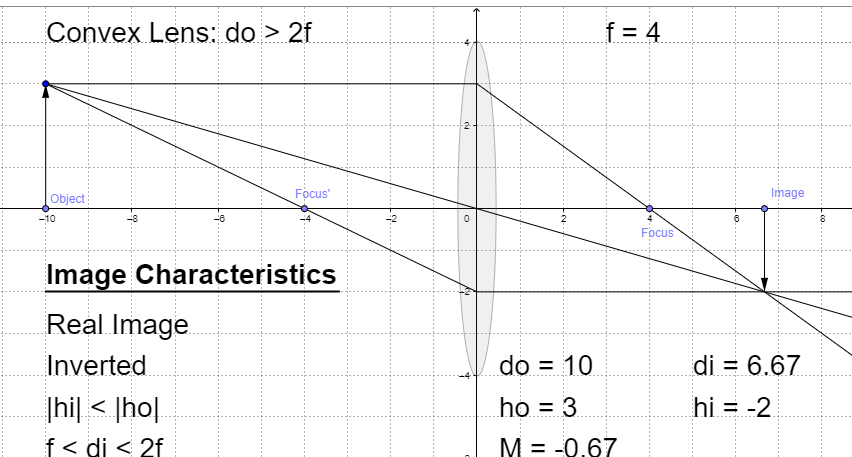
If magnification is positive, the nature of the image is:
(A) Real and inverted
(B) Virtual and erect
(C) Real
(D) None of these
Answer
508.7k+ views
Hint Magnification is given by the ratio of image size to the object size $m = \dfrac{I}{O}$ . Cartesian sign conventions say that when the ratio is positive, the image is virtual and erect. When the ratio is negative the image is real and virtual.
Complete step-by-step answer
Magnification can be defined as the ratio of size of the image to the size of the object. It is denoted by m.
$m = \dfrac{I}{O}$

For example
This magnification can tell us about the nature of the image based on the sign itself. If the ratio is negative then the image is real and inverted. If the ratio is positive then the image is virtual and erect.
So, according to these sigh conventions, when the magnification is positive then the image has to be erect and virtual.
Hence, the correct option will be B.
Note Lateral magnification is when an object is placed perpendicular to the principle axis.
$m = - \dfrac{v}{u}$
Axial magnification is when object lies on the principle axis
$m = - \dfrac{{{v_2} - {v_1}}}{{{u_2} - {u_1}}}$
Areal magnification is if a 2D object is placed with its plane perpendicular to the principle axis. It is the ratio of area of image to that of object.
$m = \dfrac{{{A_i}}}{{{A_o}}}$ .
Complete step-by-step answer
Magnification can be defined as the ratio of size of the image to the size of the object. It is denoted by m.
$m = \dfrac{I}{O}$

For example
This magnification can tell us about the nature of the image based on the sign itself. If the ratio is negative then the image is real and inverted. If the ratio is positive then the image is virtual and erect.
So, according to these sigh conventions, when the magnification is positive then the image has to be erect and virtual.
Hence, the correct option will be B.
Note Lateral magnification is when an object is placed perpendicular to the principle axis.
$m = - \dfrac{v}{u}$
Axial magnification is when object lies on the principle axis
$m = - \dfrac{{{v_2} - {v_1}}}{{{u_2} - {u_1}}}$
Areal magnification is if a 2D object is placed with its plane perpendicular to the principle axis. It is the ratio of area of image to that of object.
$m = \dfrac{{{A_i}}}{{{A_o}}}$ .
Recently Updated Pages
A square frame of side 10 cm and a long straight wire class 12 physics JEE_Main

The work done in slowly moving an electron of charge class 12 physics JEE_Main

Two identical charged spheres suspended from a common class 12 physics JEE_Main

According to Bohrs theory the timeaveraged magnetic class 12 physics JEE_Main

ill in the blanks Pure tungsten has A Low resistivity class 12 physics JEE_Main

The value of the resistor RS needed in the DC voltage class 12 physics JEE_Main

Trending doubts
JEE Main 2026: Application Form Open, Exam Dates, Syllabus, Eligibility & Question Papers

Understanding Uniform Acceleration in Physics

Derivation of Equation of Trajectory Explained for Students

Hybridisation in Chemistry – Concept, Types & Applications

Understanding the Angle of Deviation in a Prism

Understanding Collisions: Types and Examples for Students

Other Pages
JEE Advanced Marks vs Ranks 2025: Understanding Category-wise Qualifying Marks and Previous Year Cut-offs

Understanding Atomic Structure for Beginners

How to Convert a Galvanometer into an Ammeter or Voltmeter

Understanding Centrifugal Force in Physics

JEE Main Marking Scheme 2026- Paper-Wise Marks Distribution and Negative Marking Details

Degree of Dissociation: Meaning, Formula, Calculation & Uses




